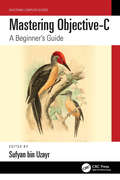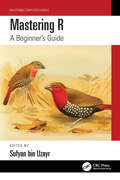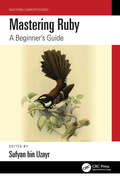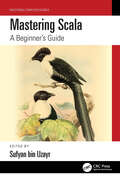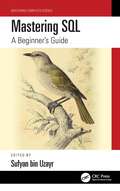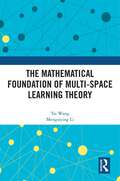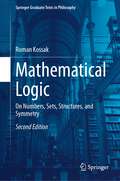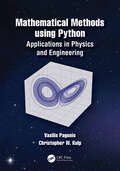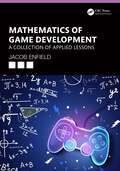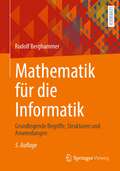- Table View
- List View
Mastering Objective-C: A Beginner's Guide (Mastering Computer Science)
by Sufyan Bin UzayrMastering Objective-C is a detailed guide for beginners that gives a modern programmer’s viewpoint on Objective-C. It introduces the principles of Objective-C and current Apple programming skills and libraries allowing the reader to make the best use of the tools available. Concise and easy to understand, this book covers many topics including, an introduction to key concepts of language and primary toolkits, as well as the Foundation and AppKit frameworks to help quickly advance with the necessary information. This book explains how to structure applications properly and organize code for optimum performance. The fundamental principles explained here are helpful to beginner and intermediate users interested in learning this highly technological and diverse language.
Mastering Objective-C: A Beginner's Guide (Mastering Computer Science)
Mastering Objective-C is a detailed guide for beginners that gives a modern programmer’s viewpoint on Objective-C. It introduces the principles of Objective-C and current Apple programming skills and libraries allowing the reader to make the best use of the tools available. Concise and easy to understand, this book covers many topics including, an introduction to key concepts of language and primary toolkits, as well as the Foundation and AppKit frameworks to help quickly advance with the necessary information. This book explains how to structure applications properly and organize code for optimum performance. The fundamental principles explained here are helpful to beginner and intermediate users interested in learning this highly technological and diverse language.
Mastering Perl: A Beginner's Guide (Mastering Computer Science)
by Sufyan Bin UzayrMastering Perl helps readers to learn the Perl programming language with real-world examples. High-level, interpreted, and multipurpose, Perl’s roots are in text manipulation. It is used for UI development in system administration, networking, and other fields, borrowing heavily from C and Shell scripts. Among programmers, Perl is also known as "Pathologically Eclectic Rubbish Lister" or "Practically Everything Really Likable." Since Perl’s inception, it has mostly been used for text processing, namely the extraction of data from text files and its subsequent transformation into other formats. In addition to being interoperable with HTML, XML, and other markup languages, Perl provides cross-platform compatibility. It is Open Source, meaning it is free to use and licensed under both the Artistic and GNU General Public Licenses (GPL). With Mastering Perl, learning Perl becomes a charm and will help readers undoubtedly advance their careers.
Mastering Perl: A Beginner's Guide (Mastering Computer Science)
by Sufyan Bin UzayrMastering Perl helps readers to learn the Perl programming language with real-world examples. High-level, interpreted, and multipurpose, Perl’s roots are in text manipulation. It is used for UI development in system administration, networking, and other fields, borrowing heavily from C and Shell scripts. Among programmers, Perl is also known as "Pathologically Eclectic Rubbish Lister" or "Practically Everything Really Likable." Since Perl’s inception, it has mostly been used for text processing, namely the extraction of data from text files and its subsequent transformation into other formats. In addition to being interoperable with HTML, XML, and other markup languages, Perl provides cross-platform compatibility. It is Open Source, meaning it is free to use and licensed under both the Artistic and GNU General Public Licenses (GPL). With Mastering Perl, learning Perl becomes a charm and will help readers undoubtedly advance their careers.
Mastering Project Discovery: Successful Discipline in Engineering and Analytics Projects
by Elliot Bendoly Daniel Bachrach Kathy Koontz Porter SchermerhornIntroducing a comprehensive approach to invigorate project leadership, this book provides a framework – the OUtCoMES Cycle – for developing, managing, advancing, and optimizing engineering and analytics projects.All too often, issues of moral hazard and completion bias prevent engineering and analytics managers and team leaders from asking the critical question 'What’s the problem?', before committing time, energy, and resources to solve it. This book draws attention to the definition, structuring, option consideration and ultimately the addressing of the right problems, exploring the OUtCoMES Cycle framework that facilitates and energizes systematic thinking, knowledge sharing, and on-the-fly adjustment with an explicit focus on the maximization of value and ROI. Each chapter includes discussions and lessons in analytical and engineering problem identification, problem structuring, iterative problem development (mental and computational) and problem resolution, at least three embedded real-world case studies, and a closing 'Practitioner’s Recap' to contextualize key chapter takeaways.Written by a team of established academic scholars and practicing analysts and engineers, this is an accessible and culture-shifting action guide for instructors interested in training the next generation of project and analytics leaders, students of analytics and engineering, as well as practicing project leaders and principals.
Mastering Project Discovery: Successful Discipline in Engineering and Analytics Projects
by Elliot Bendoly Daniel Bachrach Kathy Koontz Porter SchermerhornIntroducing a comprehensive approach to invigorate project leadership, this book provides a framework – the OUtCoMES Cycle – for developing, managing, advancing, and optimizing engineering and analytics projects.All too often, issues of moral hazard and completion bias prevent engineering and analytics managers and team leaders from asking the critical question 'What’s the problem?', before committing time, energy, and resources to solve it. This book draws attention to the definition, structuring, option consideration and ultimately the addressing of the right problems, exploring the OUtCoMES Cycle framework that facilitates and energizes systematic thinking, knowledge sharing, and on-the-fly adjustment with an explicit focus on the maximization of value and ROI. Each chapter includes discussions and lessons in analytical and engineering problem identification, problem structuring, iterative problem development (mental and computational) and problem resolution, at least three embedded real-world case studies, and a closing 'Practitioner’s Recap' to contextualize key chapter takeaways.Written by a team of established academic scholars and practicing analysts and engineers, this is an accessible and culture-shifting action guide for instructors interested in training the next generation of project and analytics leaders, students of analytics and engineering, as well as practicing project leaders and principals.
Mastering R: A Beginner's Guide (Mastering Computer Science)
R is a statistical computing and graphics programming language that you can use to clean, analyze, and graph data. It is widely used by researchers from various disciplines to estimate and display results and by teachers of statistics and research methods. This book is a detailed guide for beginners to understand R with an explanation of core statistical and research ideas. One of the powerful characteristics of R is that it is open-source, which means that anyone can access the underlying code used to run the program and add their own code for free. It will always be able to perform the latest statistical analyses as soon as anyone thinks of them. R corrects mistakes quickly and transparently and has put together a community of programming and statistical experts that you can turn to for help. Mastering R: A Beginner’s Guide not only explains how to program but also how to use R for visualization and modeling. The fundamental principles of R explained here are helpful to beginner and intermediate users interested in learning this highly technological and diverse language.
Mastering R: A Beginner's Guide (Mastering Computer Science)
by Sufyan Bin UzayrR is a statistical computing and graphics programming language that you can use to clean, analyze, and graph data. It is widely used by researchers from various disciplines to estimate and display results and by teachers of statistics and research methods. This book is a detailed guide for beginners to understand R with an explanation of core statistical and research ideas. One of the powerful characteristics of R is that it is open-source, which means that anyone can access the underlying code used to run the program and add their own code for free. It will always be able to perform the latest statistical analyses as soon as anyone thinks of them. R corrects mistakes quickly and transparently and has put together a community of programming and statistical experts that you can turn to for help. Mastering R: A Beginner’s Guide not only explains how to program but also how to use R for visualization and modeling. The fundamental principles of R explained here are helpful to beginner and intermediate users interested in learning this highly technological and diverse language.
Mastering Ruby: A Beginner's Guide (Mastering Computer Science)
Ruby is a superb programming language used for a variety of activities such as developing desktop applications, static websites, computational services, and even automation systems. Mastering Ruby: A Beginner’s Guide is a detailed guide for beginners to understand Ruby. This book discusses how to structure applications properly and organize code for optimum performance. Concise and easy to understand, this book provides the fundamentals for web programming along with software development and simple app development. It covers a variety of topics, starting from syntax styles workflow for the Command line to creating websites that will quickly advance necessary information. The key principles about Ruby explained here are helpful to beginners and users interested in learning this highly technological and diverse language. Key Features: • Follows a hands-on approach and offers practical lessons and tutorials related to Ruby. • Provides an in-depth discussion of Ruby design and applications to help build robust knowledge. • Explains how to create individual websites using Ruby programming.
Mastering Ruby: A Beginner's Guide (Mastering Computer Science)
by Sufyan Bin UzayrRuby is a superb programming language used for a variety of activities such as developing desktop applications, static websites, computational services, and even automation systems. Mastering Ruby: A Beginner’s Guide is a detailed guide for beginners to understand Ruby. This book discusses how to structure applications properly and organize code for optimum performance. Concise and easy to understand, this book provides the fundamentals for web programming along with software development and simple app development. It covers a variety of topics, starting from syntax styles workflow for the Command line to creating websites that will quickly advance necessary information. The key principles about Ruby explained here are helpful to beginners and users interested in learning this highly technological and diverse language. Key Features: • Follows a hands-on approach and offers practical lessons and tutorials related to Ruby. • Provides an in-depth discussion of Ruby design and applications to help build robust knowledge. • Explains how to create individual websites using Ruby programming.
Mastering Scala: A Beginner's Guide (Mastering Computer Science)
by Sufyan Bin UzayrScala is a multi-paradigm, general-purpose scripting language. It is a completely object-oriented programming language that supports a functional programming technique. This book is a detailed guide for beginners to understand Scala. Concise and easy to understand, Mastering Scala: A Beginner’s Guide covers a comprehensive understanding of Scala and its components, libraries, and advance concepts to help readers quickly advance with the necessary information. This book provides functional approaches for solving queries using Scala. The fundamental principles of Scala explained here are helpful to beginner and intermediate users interested in learning this highly technical and diverse language. Key Features: Follows a hands-on approach and offers practical lessons and tutorials related to Scala Includes detailed tutorials meant for beginners to Scala Discusses Scala in-depth to help build robust knowledge
Mastering Scala: A Beginner's Guide (Mastering Computer Science)
Scala is a multi-paradigm, general-purpose scripting language. It is a completely object-oriented programming language that supports a functional programming technique. This book is a detailed guide for beginners to understand Scala. Concise and easy to understand, Mastering Scala: A Beginner’s Guide covers a comprehensive understanding of Scala and its components, libraries, and advance concepts to help readers quickly advance with the necessary information. This book provides functional approaches for solving queries using Scala. The fundamental principles of Scala explained here are helpful to beginner and intermediate users interested in learning this highly technical and diverse language. Key Features: Follows a hands-on approach and offers practical lessons and tutorials related to Scala Includes detailed tutorials meant for beginners to Scala Discusses Scala in-depth to help build robust knowledge
Mastering SQL: A Beginner's Guide (Mastering Computer Science)
by Sufyan Bin UzayrMastering SQL helps readers gain a firm understanding of the Structured Query Language. Structured Query Language, more often known as SQL, is the de facto standard language for working with databases. It is a specialized language for handling data-related tasks like creating a database, putting information into tables, modifying and extracting that information, and much more. MySQL, PostgreSQL, Oracle, SQL light, etc. are only a few examples of SQL implementations. SQL is a fast and efficient database system. SQL allows for the rapid and efficient retrieval of huge numbers of data entries from a database. It’s a relational database. Thus, data is described in a more orderly fashion than in an unstructured database like MongoDB. Insertions, deletions, inquiries, manipulations, and computations of data through analytical queries in a relational database may all be performed in a matter of seconds. With Mastering SQL, learning SQL becomes straightforward; using this book and resource will undoubtedly help readers advance their careers. The Mastering Computer Science series is edited by Sufyan bin Uzayr, a writer and educator with over a decade of experience in the computing field.
Mastering SQL: A Beginner's Guide (Mastering Computer Science)
Mastering SQL helps readers gain a firm understanding of the Structured Query Language. Structured Query Language, more often known as SQL, is the de facto standard language for working with databases. It is a specialized language for handling data-related tasks like creating a database, putting information into tables, modifying and extracting that information, and much more. MySQL, PostgreSQL, Oracle, SQL light, etc. are only a few examples of SQL implementations. SQL is a fast and efficient database system. SQL allows for the rapid and efficient retrieval of huge numbers of data entries from a database. It’s a relational database. Thus, data is described in a more orderly fashion than in an unstructured database like MongoDB. Insertions, deletions, inquiries, manipulations, and computations of data through analytical queries in a relational database may all be performed in a matter of seconds. With Mastering SQL, learning SQL becomes straightforward; using this book and resource will undoubtedly help readers advance their careers. The Mastering Computer Science series is edited by Sufyan bin Uzayr, a writer and educator with over a decade of experience in the computing field.
Materials Data Science: Introduction to Data Mining, Machine Learning, and Data-Driven Predictions for Materials Science and Engineering (The Materials Research Society Series)
by Stefan SandfeldThis text covers all of the data science, machine learning, and deep learning topics relevant to materials science and engineering, accompanied by numerous examples and applications. Almost all methods and algorithms introduced are implemented “from scratch” using Python and NumPy. The book starts with an introduction to statistics and probabilities, explaining important concepts such as random variables and probability distributions, Bayes’ theorem and correlations, sampling techniques, and exploratory data analysis, and puts them in the context of materials science and engineering. Therefore, it serves as a valuable primer for both undergraduate and graduate students, as well as a review for research scientists and practicing engineers. The second part provides an in-depth introduction of (statistical) machine learning. It begins with outlining fundamental concepts and proceeds to explore a variety of supervised learning techniques for regression and classification, including advanced methods such as kernel regression and support vector machines. The section on unsupervised learning emphasizes principal component analysis, and also covers manifold learning (t-SNE and UMAP) and clustering techniques. Additionally, feature engineering, feature importance, and cross-validation are introduced. The final part on neural networks and deep learning aims to promote an understanding of these methods and dispel misconceptions that they are a “black box”. The complexity gradually increases until fully connected networks can be implemented. Advanced techniques and network architectures, including GANs, are implemented “from scratch” using Python and NumPy, which facilitates a comprehensive understanding of all the details and enables the user to conduct their own experiments in Deep Learning.
The Mathematical Foundation of Multi-Space Learning Theory
by Tai Wang Mengsiying LiThis book explores the measurement of learning effectiveness and the optimization of knowledge retention by modeling the learning process and building the mathematical foundation of multi-space learning theory.Multi-space learning is defined in this book as a micro-process of human learning that can take place in more than one space, with the goal of effective learning and knowledge retention. This book models the learning process as a temporal sequence of concept learning, drawing on established principles and empirical evidence. It also introduces the matroid to strengthen the mathematical foundation of multi-space learning theory and applies the theory to vocabulary and mathematics learning, respectively. The results show that, for vocabulary learning, the method can be used to estimate the effectiveness of a single learning strategy, to detect the mutual interference that might exist between learning strategies, and to predict the optimal combination of strategies. In mathematical learning, it was found that timing is crucial in both first learning and second learning in scheduling optimization to maximize the intersection effective interval.The title will be of interest to researchers and students in a wide range of areas, including educational technology, learning sciences, mathematical applications, and mathematical psychology.
The Mathematical Foundation of Multi-Space Learning Theory
by Tai Wang Mengsiying LiThis book explores the measurement of learning effectiveness and the optimization of knowledge retention by modeling the learning process and building the mathematical foundation of multi-space learning theory.Multi-space learning is defined in this book as a micro-process of human learning that can take place in more than one space, with the goal of effective learning and knowledge retention. This book models the learning process as a temporal sequence of concept learning, drawing on established principles and empirical evidence. It also introduces the matroid to strengthen the mathematical foundation of multi-space learning theory and applies the theory to vocabulary and mathematics learning, respectively. The results show that, for vocabulary learning, the method can be used to estimate the effectiveness of a single learning strategy, to detect the mutual interference that might exist between learning strategies, and to predict the optimal combination of strategies. In mathematical learning, it was found that timing is crucial in both first learning and second learning in scheduling optimization to maximize the intersection effective interval.The title will be of interest to researchers and students in a wide range of areas, including educational technology, learning sciences, mathematical applications, and mathematical psychology.
Mathematical Logic: On Numbers, Sets, Structures, and Symmetry (Springer Graduate Texts in Philosophy #4)
by Roman KossakThis textbook is a second edition of the successful, Mathematical Logic: On Numbers, Sets, Structures, and Symmetry. It retains the original two parts found in the first edition, while presenting new material in the form of an added third part to the textbook. The textbook offers a slow introduction to mathematical logic, and several basic concepts of model theory, such as first-order definability, types, symmetries, and elementary extensions. Part I, Logic Sets, and Numbers, shows how mathematical logic is used to develop the number structures of classical mathematics. All necessary concepts are introduced exactly as they would be in a course in mathematical logic; but are accompanied by more extensive introductory remarks and examples to motivate formal developments. The second part, Relations, Structures, Geometry, introduces several basic concepts of model theory, such as first-order definability, types, symmetries, and elementary extensions, and shows how they are usedto study and classify mathematical structures. The added Part III to the book is closer to what one finds in standard introductory mathematical textbooks. Definitions, theorems, and proofs that are introduced are still preceded by remarks that motivate the material, but the exposition is more formal, and includes more advanced topics. The focus is on the notion of countable categoricity, which analyzed in detail using examples from the first two parts of the book. This textbook is suitable for graduate students in mathematical logic and set theory and will also be of interest to mathematicians who know the technical aspects of the subject, but are not familiar with its history and philosophical background.
Mathematical Methods using Python: Applications in Physics and Engineering
by Vasilis Pagonis Christopher Wayne KulpThis advanced undergraduate textbook presents a new approach to teaching mathematical methods for scientists and engineers. It provides a practical, pedagogical introduction to utilizing Python in Mathematical and Computational Methods courses. Both analytical and computational examples are integrated from its start. Each chapter concludes with a set of problems designed to help students hone their skills in mathematical techniques, computer programming, and numerical analysis. The book places less emphasis on mathematical proofs, and more emphasis on how to use computers for both symbolic and numerical calculations. It contains 182 extensively documented coding examples, based on topics that students will encounter in their advanced courses in Mechanics, Electronics, Optics, Electromagnetism, Quantum Mechanics etc.An introductory chapter gives students a crash course in Python programming and the most often used libraries (SymPy, NumPy, SciPy, Matplotlib). This is followed by chapters dedicated to differentiation, integration, vectors and multiple integration techniques. The next group of chapters covers complex numbers, matrices, vector analysis and vector spaces. Extensive chapters cover ordinary and partial differential equations, followed by chapters on nonlinear systems and on the analysis of experimental data using linear and nonlinear regression techniques, Fourier transforms, binomial and Gaussian distributions. The book is accompanied by a dedicated GitHub website, which contains all codes from the book in the form of ready to run Jupyter notebooks. A detailed solutions manual is also available for instructors using the textbook in their courses.Key Features:· A unique teaching approach which merges mathematical methods and the Python programming skills which physicists and engineering students need in their courses.· Uses examples and models from physical and engineering systems, to motivate the mathematics being taught.· Students learn to solve scientific problems in three different ways: traditional pen-and-paper methods, using scientific numerical techniques with NumPy and SciPy, and using Symbolic Python (SymPy).Vasilis Pagonis is Professor of Physics Emeritus at McDaniel College, Maryland, USA. His research area is applications of thermally and optically stimulated luminescence. He taught courses in mathematical physics, classical and quantum mechanics, analog and digital electronics and numerous general science courses. Dr. Pagonis’ resume lists more than 200 peer-reviewed publications in international journals. He is currently associate editor of the journal Radiation Measurements. He is co-author with Christopher Kulp of the undergraduate textbook “Classical Mechanics: a computational approach, with examples in Python and Mathematica” (CRC Press, 2020). He has also co-authored four graduate-level textbooks in the field of luminescence dosimetry, and most recently published the book “Luminescence Signal analysis using Python” (Springer, 2022).Christopher Kulp is the John P. Graham Teaching Professor of Physics at Lycoming College. He has been teaching undergraduate physics at all levels for 20 years. Dr. Kulp’s research focuses on modelling complex systems, time series analysis, and machine learning. He has published 30 peer-reviewed papers in international journals, many of which include student co-authors. He is also co-author of the undergraduate textbook “Classical Mechanics: a computational approach, with examples in Python and Mathematica” (CRC Press, 2020).
Mathematical Methods using Python: Applications in Physics and Engineering
by Vasilis Pagonis Christopher Wayne KulpThis advanced undergraduate textbook presents a new approach to teaching mathematical methods for scientists and engineers. It provides a practical, pedagogical introduction to utilizing Python in Mathematical and Computational Methods courses. Both analytical and computational examples are integrated from its start. Each chapter concludes with a set of problems designed to help students hone their skills in mathematical techniques, computer programming, and numerical analysis. The book places less emphasis on mathematical proofs, and more emphasis on how to use computers for both symbolic and numerical calculations. It contains 182 extensively documented coding examples, based on topics that students will encounter in their advanced courses in Mechanics, Electronics, Optics, Electromagnetism, Quantum Mechanics etc.An introductory chapter gives students a crash course in Python programming and the most often used libraries (SymPy, NumPy, SciPy, Matplotlib). This is followed by chapters dedicated to differentiation, integration, vectors and multiple integration techniques. The next group of chapters covers complex numbers, matrices, vector analysis and vector spaces. Extensive chapters cover ordinary and partial differential equations, followed by chapters on nonlinear systems and on the analysis of experimental data using linear and nonlinear regression techniques, Fourier transforms, binomial and Gaussian distributions. The book is accompanied by a dedicated GitHub website, which contains all codes from the book in the form of ready to run Jupyter notebooks. A detailed solutions manual is also available for instructors using the textbook in their courses.Key Features:· A unique teaching approach which merges mathematical methods and the Python programming skills which physicists and engineering students need in their courses.· Uses examples and models from physical and engineering systems, to motivate the mathematics being taught.· Students learn to solve scientific problems in three different ways: traditional pen-and-paper methods, using scientific numerical techniques with NumPy and SciPy, and using Symbolic Python (SymPy).Vasilis Pagonis is Professor of Physics Emeritus at McDaniel College, Maryland, USA. His research area is applications of thermally and optically stimulated luminescence. He taught courses in mathematical physics, classical and quantum mechanics, analog and digital electronics and numerous general science courses. Dr. Pagonis’ resume lists more than 200 peer-reviewed publications in international journals. He is currently associate editor of the journal Radiation Measurements. He is co-author with Christopher Kulp of the undergraduate textbook “Classical Mechanics: a computational approach, with examples in Python and Mathematica” (CRC Press, 2020). He has also co-authored four graduate-level textbooks in the field of luminescence dosimetry, and most recently published the book “Luminescence Signal analysis using Python” (Springer, 2022).Christopher Kulp is the John P. Graham Teaching Professor of Physics at Lycoming College. He has been teaching undergraduate physics at all levels for 20 years. Dr. Kulp’s research focuses on modelling complex systems, time series analysis, and machine learning. He has published 30 peer-reviewed papers in international journals, many of which include student co-authors. He is also co-author of the undergraduate textbook “Classical Mechanics: a computational approach, with examples in Python and Mathematica” (CRC Press, 2020).
Mathematical Modeling and Supercomputer Technologies: 23rd International Conference, MMST 2023, Nizhny Novgorod, Russia, November 13–16, 2023, Revised Selected Papers (Communications in Computer and Information Science #1914)
by Dmitry Balandin Konstantin Barkalov Iosif MeyerovThis book constitutes selected and revised papers from the 23rd International Conference on Mathematical Modeling and Supercomputer Technologies, MMST 2023, held in Nizhny Novgorod, Russia, during November 13–16 2023. The 18 full papers and 7 short papers presented in the volume were thoroughly reviewed and selected from the 45 submissions. They are organized in topical sections as follows: computational methods for mathematical models analysis; computation in optimization and optimal control; artificial intelligence and supercomputer simulation.
Mathematics and Computation in Music: 9th International Conference, MCM 2024, Coimbra, Portugal, June 18–21, 2024, Proceedings (Lecture Notes in Computer Science #14639)
by Thomas Noll Mariana Montiel Francisco Gómez Omar Costa Hamido José Luis Besada José Oliveira MartinsThis book constitutes the refereed proceedings of the 9th International Conference on Mathematics and Computation in Music, MCM 2024, held in Coimbra, Portugal, during June 18–21, 2024. The 30 full papers and 9 short papers included in this book were carefully reviewed and selected from 45 submissions. They were organized in topical sections as follows: mathematical scale theory and tuning; rhythm analysis and rhythm generation; categorical and algebraic approaches to music; quantum music; theory and algorithms for melodic- harmonic analysis and generation; geometric approaches to musical algorithms and microtonality; fourier analysis for music; similarity and distance measures for music; short papers; communication-performances; and tribute to Yves Hellegouarch.
Mathematics of Game Development: A Collection of Applied Lessons
by Jacob EnfieldThis introductory textbook introduces students to mathematical concepts and helps them to understand how they apply to the field of game development. This book covers the mathematical concepts commonly used in game development while providing opportunities to apply these concepts in the industry-standard Unity game engine.Most chapters cover mathematical concepts commonly used in game development, a downloadable game project that will provide a context to apply the math concepts learned, exercises for readers to practice the math concepts covered, and challenges for readers to further practice applying those concepts.This book will be ideal for any game development student looking to gain a grounding in the most relevant mathematical concepts to support their trade. It will also be useful as a stepping stone to digesting more advanced mathematical concepts for game development.
Mathematics of Game Development: A Collection of Applied Lessons
by Jacob EnfieldThis introductory textbook introduces students to mathematical concepts and helps them to understand how they apply to the field of game development. This book covers the mathematical concepts commonly used in game development while providing opportunities to apply these concepts in the industry-standard Unity game engine.Most chapters cover mathematical concepts commonly used in game development, a downloadable game project that will provide a context to apply the math concepts learned, exercises for readers to practice the math concepts covered, and challenges for readers to further practice applying those concepts.This book will be ideal for any game development student looking to gain a grounding in the most relevant mathematical concepts to support their trade. It will also be useful as a stepping stone to digesting more advanced mathematical concepts for game development.
Mathematik für die Informatik: Grundlegende Begriffe, Strukturen und Anwendungen
by Rudolf BerghammerMathematik für die Informatik: Dieses Buch bringt Ihnen die Grundlagen beiDieses Lehrbuch bietet eine Einführung in die grundlegenden Begriffe und Strukturen der Mathematik, welche am Anfang eines Informatikstudiums relevant sind. Weiterhin demonstriert es Anwendungen von mathematischen Konzepten und Methoden in der Informatik. Diese betreffen insbesondere formale Methoden der Programmverifikation und -entwicklung und den Entwurf von generischen Programmen. Ein spezielles Konzept mit einer leicht verständlichen Vermittlung des Stoffs, vielen Beispielen mit Rückgriffen auf die Schulmathematik und detaillierten Beweisen (verbunden mit der Erklärung des logischen Hintergrunds) erleichtert den Einstieg in die Mathematik an einer wissenschaftlichen Hochschule. Dadurch werden die Studierenden auch auf spätere Begriffe und tiefergehende Anwendungen der Mathematik in der Informatik gut vorbereitet. Die 5. Auflage erweitert den Inhalt um die Grundlagen der linearen Algebra. Die Übungsaufgaben zu den einzelnen Kapitel helfen, das Erlernte zu festigen und zu kontrollieren. Zahlreiche Lösungsvorschläge am Ende des Buchs ermöglichen die Überprüfung der eigenen Lösungen.Der InhaltMengentheoretische Grundlagen • Logische Grundlagen • Allgemeine direkte Produkte und Datenstrukturen • Mathematische Beweise • Spezifikation und Programmverifikation • Spezielle Funktionen • Spezielle Relationen und gerichtete Graphen • Elementare Kombinatorik und ungerichtete Graphen • Diskrete Wahrscheinlichkeitstheorie • Generische Programmierung • Grundbegriffe algebraischer Strukturen • Formale Einführung der natürlichen Zahlen - Grundbegriffe der linearen AlgebraMit diesem Buch gelingt der Einstieg ins Informatik-StudiumMit diesem Buch schaffen Sie eine solide Basis für die Mathematikausbildung im Rahmen desInformatikstudiums. Zudem sind Sie durch die vorgestellten Problemstellungen in der Lage, selbstständig mathematische Konzepte und Methoden anzuwenden. Zielgruppen dieses Buchs über Mathematik in der Informatik sind Bachelor-Studierende in den ersten Studiensemestern folgender Fachbereiche:InformatikMathematikIngenieurwissenschaften
